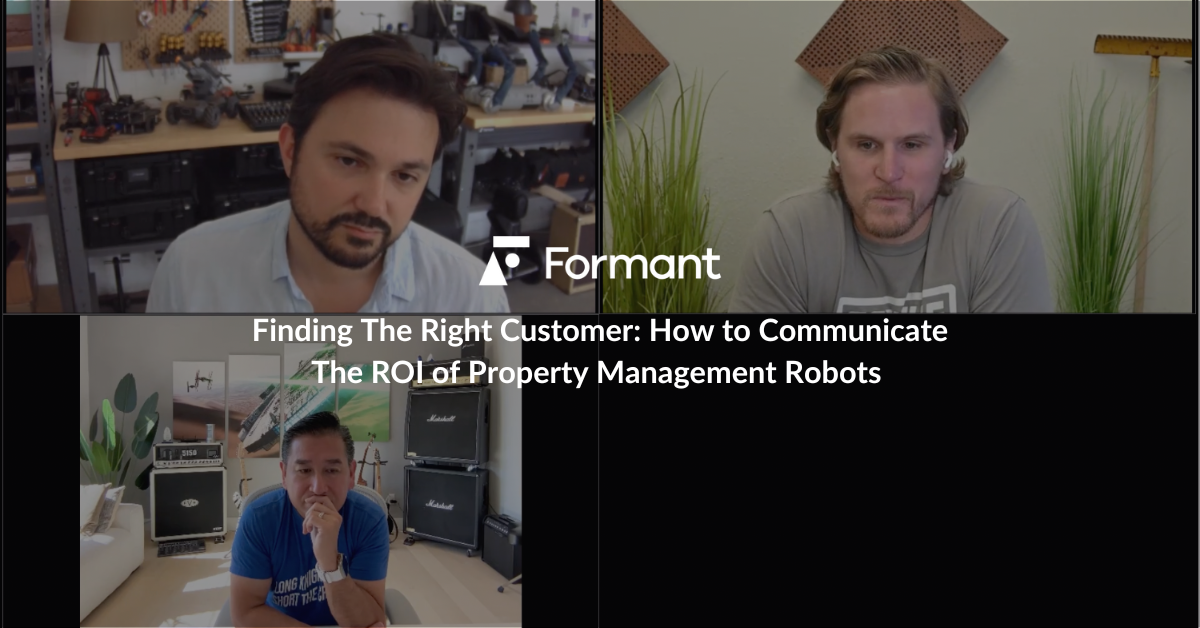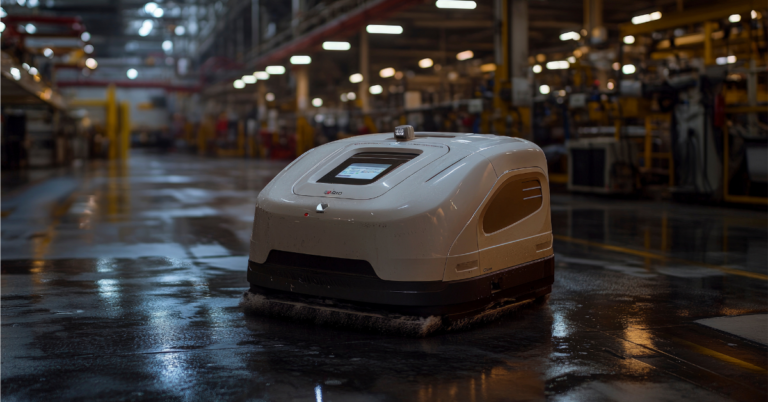This blog is taken from a transcript of our recent webinar, “The Potential of Autonomous Robots In Property Management”, discussing how to communicate ROI and find the right customers. It has been slightly modified for reading. Featured speakers are Jack Morrison, CEO of Scythe Robotics & William (Bill) Santana Li, CEO of Knightscope, hosted by James Turnshek, Chief Architect at Formant.
James Turnshek: Jack, I’m wondering how you talk about ROI and how customers think about that- is it a straight-up labor replacement- we’re going to do more faster? What are the kind of key parameters they’re trying to optimize?
Jack Morrison: Yeah, there’s a bunch of different ways that our customers see value out of using M.52, number one is replacing those really fault-prone gas mowers and lowering their repair costs, how many mechanics, how many hours of their mechanics’ time they need, and their gas bills go down. I mean, their gas bills go to zero, and their electricity bills are a tenth the cost because these machines are so much more efficient.
And then in terms of the autonomous value prop, we’re not a human replacement device. We are a way for these businesses to grow. They’ve done the hard work of finding a hundred, a thousand people to work on their teams, and they know that they couldn’t survive without those people. But what we let them do is instead of having 100 person weeks worth of work they can get done each week, now they have effectively a hundred and fifty or two hundred once they fully roll out M.52. And because we charge really a minimal amount upfront, today you can reserve ten M.52 units for 1,000 dollars. So 100 dollars per robot to reserve them, then a 900-dollar shipping fee to get them on-site when we deploy them. A thousand dollars per mower is much less than any gas mower, even the down payment on financing for it. And so the ROI from there is pretty much immediate.
Once they’ve put a few hours of training on the guys who are going to use the machine, they can take it out there and immediately start seeing 20, 40, 60, 80 percent of the properties that they put those mowers on automated for them, and the mowing automated so that they immediately can move guys onto new truck crews and get more work done with them. Or, just not churn the customers that they already have.
One of our Texas customers had a property account manager- the guy at our customer who was responsible for interface property manager- he was terrified to see the property manager. He knew they were going to get fired. Their quality was just not where they knew it needed to be, but they didn’t have the man manpower to do it.
And so they put our mower out there and all of a sudden the guy could actually go pick up the trash instead of just mowing over it because he was in such a rush. And it went from one of their worst properties to one of their best properties, and they actually were able to expand with that property manager because they had this additional manpower.
James Turnshek: Amazing, that’s great. Bill, I wonder for you the same thing. My intuition is that physical safety is almost infinitely valuable to a lot of people. And so that probably plays a big part in it, but what kind of ROI parameters do you generally talk about when you’re selling?
William (Bill) Santana Li: Highly client-specific, highly vertical-specific, highly deployment/ location specific. Probably, if I were to whittle it down, it goes into one, two, or three buckets, and I’ll say the first bucket is probably the worst one that we absolutely want to avoid: the worst client we’ve had or as a just a category is the Chief Innovation Officer. Right? Just got promoted, have a budget, need a shiny object. Let’s go get a robot for our location.
You don’t actually have a problem to solve, like when it comes down to the renewal, it becomes really difficult if you didn’t solve any problems. Well, you didn’t have any in the first place. So we’re trying to turn down business now because we’ve got like a five million dollar backlog of new orders, and we’ve just got enough to deal with on that.
So I think despite the media talking point of, hey, the robot’s gonna take everyone’s job, I think for my earlier comments, it’s pretty obvious the country doesn’t have enough officers and guards, so we can just discount that off the top. A significant majority of our clients are looking to provide their officers and guards tools or give them superhuman capabilities to do their jobs more effectively and are looking to supplement.
And then in other cases, there’s literally a budget problem, which is an off-duty law enforcement officer armed is 85 bucks an hour. An unarmed guard is depending on what you want him or her to do 15 to 35 bucks an hour. We start at 75 cents, and we end at nine bucks an hour. You’ve got cold hard cash to help there.
And in some cases, it’s literally that you’ve got a recurring problem; we’ve tried everything, but nothing works. We put signs up, we put guards up, we put everything in. Probably the most poignant example was some time ago- our longest serving client is probably now seven years of renewals. And when we first met them, they’re like, listen- it’s a hospital- they had one to two criminal incidents a week, assault, theft, stolen car every single week. Finally, like the security guards, says,
“I’m not going out there at night. Forget it. You can fire me. I’m not going there.”
And imagine being a nurse or a doctor, your shift ends at three in the morning, now you have to go through the minefield to get to your car, not a great work environment.
So we’re a little hesitant, right? But we put the robot there, and all the nonsense literally went down to zero.
You don’t get a client to pay you full price for seven years if you’re not creating some value. And part of it is just that physical deterrent. It’s not so obvious for a lot of people that aren’t in public safety or security when you pull up into a parking lot- a lot of crimes are of the moment. Right? Some emotional type of thing.
You pull into a parking lot at three o’clock in the morning. You see this 400-pound machine roaming around. The strobe light’s going. It says police or security on the side. It may say something. There are some sounds going on. You have no idea what it does.
“You know what, guys? I’m gonna go steal the car down the street. I don’t need to be here.”
And that physical deterrence has been a huge, huge win for our clients. So I think to wrap it up, it’s probably around, you know, the actual budget. You actually have a crime problem or you’re trying to get some tools to cover more ground with the humans that you have.
James Turnshek: Yeah, okay, that’s great. And it sounds like over time, you can probably track the number of incidents and just see the drop-off. Right?
William (Bill) Santana Li: In some cases, yes. The security industry is a little weird though, because you try to do an ROI. And so you spent three million dollars on security guards over the last three years. You know, like, show me the value. Right? And the unfortunate Chief Security Officers in most cases are low man on the totem pole. And where is the easiest place to cut?
Oh, well, there’s nothing going on here. You’re a cost center. You don’t enhance the brand. You don’t do anything. Like, let’s take some money away.
And of course, what happens? They start cutting budgets, cutting budgets, and then when something happens, it’s oh my God! We need to do a review of the budget and all these other things. And why haven’t we been spending the appropriate time? This is similar to the cyber stuff. Like, don’t spend anything until you get hacked, and then all of a sudden you start spending like crazy.
If you’re interested in learning more about property management robots, you can view the entire webinar for free, or read more on our blog post, “How Automation Is Revolutionizing Facilities Management”.
At Formant, we’re excited about the potential of robots across property management tasks from cleaning to security, mowing, floor scrubbing, and more. If you’d like to learn about how Formant can support the operations of robots deployed onto properties, you can request a demo with our team.



